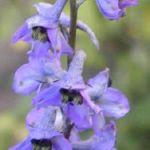| Common Name: |
Stavesacre |
| Botanical Name: |
Delphinium staphisagria |
| Genus: |
Delphinium |
| Family: |
Ranunculaceae |
| Native Location: |
Meditteranean regions |
| Cultivation: |
Well-drained soil in sun. |
| Propagation: |
By seed sown in spring at 13°C (55°F) |
| Harvest: |
Seeds are collected when ripe for use in lotions and ointments. |
| Height: |
1.5m (5ft) |
| Width: |
45-75cm (18-30in) |
| Hardiness: |
Z9 |
| Parts Used: |
Seeds |
| Properties: |
An acrid, bitter herb with potent insecticidal properties and parasiticidal effects. |
| Medicinal Uses: |
Externally for head lice. |
| Warning: |
Toxic if eaten |
| Bibliography: |
Encylopedia of Herbs by Deni Brown Copyright ©: 1995, 2001 Dorling Kindersley Limited pps. 191-192
|

